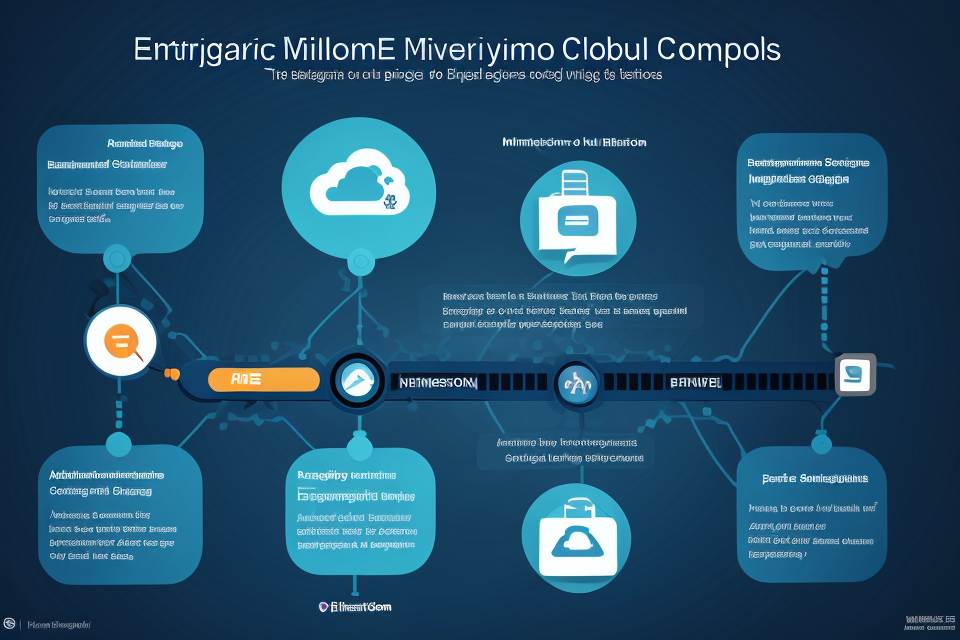The digital transformation is a phenomenon that has profoundly changed the way we live, work, and interact with each other. But when did it all begin? The digital transformation can be traced back to the invention of the computer, but its true genesis can be pinpointed to a few key events and developments over the past few decades. This timeline provides a comprehensive overview of the digital transformation, from its earliest beginnings to the present day.
The Emergence of Digital Technologies
The Invention of the First Computers
- The birth of the modern computer: The ENIAC
- The Electronic Numerical Integrator and Computer (ENIAC) was the first general-purpose electronic computer.
- It was completed in 1945, and was used for calculating ballistic trajectories for the U.S. military.
- The ENIAC was designed and built by John Mauchly and J. Presper Eckert, who were later referred to as the “founding fathers of the computer.”
- The development of the first general-purpose electronic computer: The UNIVAC
- The UNIVAC (Universal Automatic Computer) was the first computer to be sold to the general public.
- It was developed by the company Remington Rand and was delivered to the U.S. Census Bureau in 1951.
- The UNIVAC was designed to perform a wide range of calculations, including scientific, business, and engineering applications.
- It was also used for the first time in the United States presidential election in 1952, where it helped predict the winner of the election.
The Advent of the Internet
The advent of the internet marked a significant turning point in the history of digital technologies. It revolutionized the way people communicate, access information, and conduct business.
- The ARPANET and the birth of the internet
The ARPANET, also known as the “granddaddy of the internet,” was a research project funded by the U.S. Department of Defense in the late 1960s. It was designed to connect computers at different universities and research institutions to facilitate the sharing of information and resources.
The first successful connection was made between the University of California, Los Angeles (UCLA) and the Stanford Research Institute (SRI) in 1969. This marked the beginning of the internet as we know it today.
- The creation of the first web page by Tim Berners-Lee
In 1989, Tim Berners-Lee, a British computer scientist, invented the World Wide Web while working at CERN, the European Organization for Nuclear Research. He created the first web page, which consisted of a simple text document with hyperlinks to other pages.
This invention transformed the internet from a mere network of computers into a global information system that could be accessed by anyone with an internet connection. It revolutionized the way people accessed and shared information, and it paved the way for the development of e-commerce, social media, and other online platforms that we know today.
The Evolution of Digital Technologies
The Rise of Personal Computers
The emergence of personal computers revolutionized the way people interacted with technology and played a crucial role in the digital transformation of society. Here are some key events that marked the rise of personal computers:
The Launch of the IBM PC
In 1981, IBM released the first IBM PC, which was the first personal computer to gain widespread acceptance in the business world. The IBM PC was equipped with a 4.77 MHz Intel 8088 processor, 16KB of RAM, and the MS-DOS operating system. Its success set the stage for the widespread adoption of personal computers in the workplace.
The Introduction of the Apple Macintosh
In 1984, Apple released the Macintosh, which was the first personal computer to feature a graphical user interface (GUI). The Macintosh was designed to be user-friendly and accessible to non-technical users, making it an attractive alternative to the more complex IBM PC. Its introduction marked the beginning of a new era of personal computing and helped to popularize the use of graphical interfaces on personal computers.
The rise of personal computers had a profound impact on society, transforming the way people work, communicate, and access information. The development of personal computers paved the way for the widespread adoption of the internet and the digital revolution that followed.
The Growth of the Internet
- The commercialization of the internet
- The emergence of the first internet service providers (ISPs) in the late 1980s and early 1990s
- Companies such as CompuServe, America Online (AOL), and Prodigy led the way in providing internet access to a wider audience
- The expansion of internet infrastructure and the development of new technologies, such as the World Wide Web (WWW) and email, in the mid-1990s
- The launch of Netscape Navigator in 1994 marked a turning point in the commercialization of the internet, making it more accessible and user-friendly for the general public
- The emergence of the first internet service providers (ISPs) in the late 1980s and early 1990s
- The proliferation of online services and applications
- The growth of e-commerce and online businesses in the late 1990s and early 2000s
- Companies such as Amazon, eBay, and PayPal revolutionized the way people shop and conduct financial transactions online
- The rise of social media and online networking platforms in the mid-2000s
- Websites like Facebook, Twitter, and LinkedIn changed the way people communicate and connect with others online, creating new opportunities for personal and professional networking
- The development of mobile internet and the widespread adoption of smartphones in the late 2000s and early 2010s
- The proliferation of mobile apps and mobile-optimized websites led to a significant increase in online activity and the growth of the mobile economy.
- The growth of e-commerce and online businesses in the late 1990s and early 2000s
The Impact of Digital Technologies
The Digital Revolution
The digital revolution refers to the widespread adoption and integration of digital technologies into various aspects of human life, transforming the way we live, work, and communicate. This section will explore the key developments and events that marked the beginning of the digital revolution.
The Emergence of the Internet
The birth of the internet is often considered the starting point of the digital revolution. In 1969, the first version of the internet was developed by the United States Department of Defense to facilitate communication between military bases. Over the next few decades, the internet grew rapidly, and by the 1990s, it had become a ubiquitous part of daily life.
The Rise of Personal Computers
The personal computer revolutionized the way people interacted with digital technology. In 1984, Apple Inc. introduced the Macintosh, the first commercially successful personal computer. This was followed by the launch of Microsoft Windows, which became the dominant operating system for personal computers. The widespread adoption of personal computers made the internet accessible to a broader audience, fueling the growth of the digital revolution.
The Development of the World Wide Web
In 1989, Tim Berners-Lee, a British computer scientist, developed the World Wide Web, which transformed the internet from a static database to an interactive platform. The web made it possible for people to access and share information globally, revolutionizing the way we access and exchange information.
The Advent of Mobile Devices
The introduction of mobile devices, such as smartphones and tablets, marked another significant milestone in the digital revolution. In 1993, the first mobile phone with text messaging capabilities was launched, and by the early 2000s, smartphones with internet connectivity had become popular. Today, mobile devices are an integral part of daily life, providing access to the internet and a wide range of digital services.
The Expansion of Digital Services
The digital revolution has led to the emergence of various digital services, including e-commerce, social media, streaming services, and cloud computing. These services have transformed the way we shop, socialize, and work, making digital technology an indispensable part of modern life.
In conclusion, the digital revolution began with the emergence of the internet, the rise of personal computers, and the development of the World Wide Web. The advent of mobile devices and the expansion of digital services have further fueled the growth of the digital revolution, transforming industries and business models and giving rise to the gig economy and remote work.
The Changing Landscape of Society
- The rise of social media and online communities
- The emergence of early social media platforms such as SixDegrees.com (1997) and Friendster (2002) marked the beginning of online communities where individuals could connect and share information with others.
- The launch of MySpace (2003) and LinkedIn (2003) further expanded the social media landscape, enabling users to create profiles, connect with others, and share content.
- The rise of Facebook (2004) revolutionized social media, rapidly becoming one of the most widely used platforms for connecting with friends, family, and acquaintances.
- The launch of Twitter (2006) introduced the concept of microblogging, allowing users to share short messages and updates with their followers.
- The growth of Instagram (2010) and other visual-based social media platforms transformed the way people share and consume content, with a focus on images and videos.
- The evolution of digital communication and entertainment
- The advent of email and instant messaging services such as AOL Instant Messenger (1997) and Yahoo Messenger (1999) revolutionized communication, enabling users to instantly message each other from anywhere in the world.
- The introduction of video calling services such as Skype (2003) and Google Hangouts (2006) transformed the way people communicate, allowing for face-to-face conversations despite physical distance.
- The rise of streaming services such as Netflix (2007) and YouTube (2005) transformed the entertainment industry, enabling users to access a vast library of movies, TV shows, and other content from the comfort of their own homes.
- The emergence of mobile gaming and mobile apps transformed the way people entertain themselves, with access to a wide range of games and other digital content on their smartphones.
The Future of Digital Transformation
Emerging Technologies and Trends
- Artificial Intelligence and Machine Learning
Artificial intelligence (AI) and machine learning (ML) have emerged as key technologies driving digital transformation. These technologies are transforming the way businesses operate, from customer service to manufacturing, and from healthcare to finance. AI and ML are being used to automate processes, make predictions, and provide personalized experiences. For example, AI-powered chatbots are being used to provide customer support, while ML algorithms are being used to detect fraud and anomalies in financial transactions.
- The Internet of Things (IoT)
The Internet of Things (IoT) is another technology that is transforming the way businesses operate. IoT refers to the network of physical devices, vehicles, and other objects that are embedded with sensors, software, and connectivity to enable them to collect and exchange data. IoT is being used in various industries, including manufacturing, agriculture, and healthcare, to improve efficiency, reduce costs, and create new products and services. For example, in manufacturing, IoT sensors are being used to monitor equipment performance and predict maintenance needs, while in healthcare, IoT devices are being used to monitor patient health and provide remote care.
- Cloud Computing
Cloud computing is another technology that is transforming the way businesses operate. Cloud computing refers to the delivery of computing services, including servers, storage, and applications, over the internet. Cloud computing is being used to provide flexibility, scalability, and cost savings to businesses. For example, cloud-based software is being used to provide remote access to business applications, while cloud-based storage is being used to store and manage large amounts of data.
- 5G Networks
5G networks are the latest generation of mobile networks, offering faster speeds, lower latency, and greater capacity than previous generations. 5G networks are being used to support new applications, such as virtual and augmented reality, autonomous vehicles, and smart cities. 5G networks are also being used to support the growth of IoT devices, as they provide the necessary bandwidth and low latency to support the massive amount of data generated by these devices.
- Blockchain Technology
Blockchain technology is a decentralized and secure way of storing and managing data. Blockchain technology is being used in various industries, including finance, healthcare, and supply chain management, to improve transparency, reduce fraud, and streamline processes. For example, blockchain technology is being used to track the origin and ownership of goods in the supply chain, while in healthcare, it is being used to securely store and manage patient health data.
- Quantum Computing
Quantum computing is a new type of computing that uses quantum-mechanical phenomena, such as superposition and entanglement, to perform operations on data. Quantum computing has the potential to solve complex problems that are beyond the capabilities of classical computers. For example, quantum computers can be used to simulate complex molecules for drug discovery, or to crack encryption codes for cybersecurity.
Overall, these emerging technologies and trends are shaping the future of digital transformation, and businesses must stay informed and adapt to these changes to remain competitive.
The Ongoing Evolution of Digital Technologies
- New Innovations and Breakthroughs
The digital transformation has led to numerous breakthroughs in technology. From artificial intelligence to blockchain, the potential for new innovations is endless. These advancements are transforming industries and improving the way we live and work.
- Challenges and Opportunities of the Digital Age
As digital technologies continue to evolve, new challenges and opportunities arise. One of the biggest challenges is the need for companies to adapt to the changing landscape. Those who are able to embrace new technologies and adapt to the digital age will be well-positioned for success. On the other hand, those who fail to adapt may struggle to remain relevant. Additionally, the digital age presents new opportunities for collaboration and innovation, as well as new ways to reach customers and expand businesses. Overall, the ongoing evolution of digital technologies is both exciting and challenging, and will continue to shape the future in profound ways.
FAQs
1. When did the digital transformation begin?
The digital transformation can be traced back to the 1960s, when computers first started being used for business purposes. However, it was not until the 1990s that the term “digital transformation” was widely used to describe the integration of digital technology into various industries and aspects of life. The process has accelerated rapidly in recent years, with the rise of new technologies such as the internet, mobile devices, and artificial intelligence.
2. What was the first significant event in the digital transformation?
One of the earliest significant events in the digital transformation was the invention of the first general-purpose electronic computer, the ENIAC, in 1946. This marked the beginning of the widespread use of computers in business and industry. In the following decades, the development of new technologies such as the internet, personal computers, and mobile devices continued to drive the digital transformation.
3. How has the digital transformation impacted various industries?
The digital transformation has had a profound impact on virtually every industry, from retail and banking to healthcare and manufacturing. It has enabled businesses to become more efficient and competitive by automating processes, improving communication, and enhancing the customer experience. It has also created new opportunities for innovation and growth.
4. What are some key technologies that have driven the digital transformation?
Several key technologies have driven the digital transformation, including the internet, personal computers, mobile devices, and artificial intelligence. The internet has revolutionized the way we communicate and access information, while personal computers and mobile devices have made digital technology more accessible to individuals and businesses. Artificial intelligence has enabled the development of new applications and services that are transforming industries and improving efficiency.
5. What is the future of the digital transformation?
The digital transformation is likely to continue at a rapid pace in the coming years, with the development of new technologies such as the Internet of Things, blockchain, and virtual and augmented reality. These technologies will bring new opportunities for innovation and growth, as well as new challenges for businesses and individuals to navigate. It is important for individuals and organizations to stay informed about the latest developments in the digital transformation in order to stay competitive and adapt to the changing landscape.



